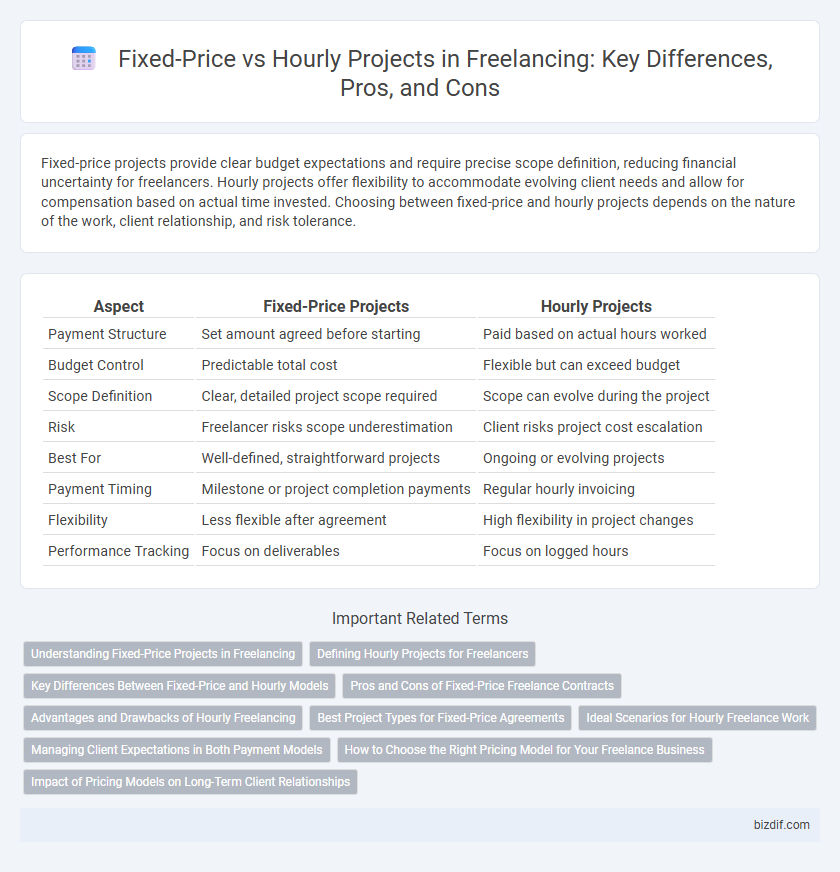Fixed-price projects provide clear budget expectations and require precise scope definition, reducing financial uncertainty for freelancers. Hourly projects offer flexibility to accommodate evolving client needs and allow for compensation based on actual time invested. Choosing between fixed-price and hourly projects depends on the nature of the work, client relationship, and risk tolerance.
Table of Comparison
| Aspect | Fixed-Price Projects | Hourly Projects |
|---|---|---|
| Payment Structure | Set amount agreed before starting | Paid based on actual hours worked |
| Budget Control | Predictable total cost | Flexible but can exceed budget |
| Scope Definition | Clear, detailed project scope required | Scope can evolve during the project |
| Risk | Freelancer risks scope underestimation | Client risks project cost escalation |
| Best For | Well-defined, straightforward projects | Ongoing or evolving projects |
| Payment Timing | Milestone or project completion payments | Regular hourly invoicing |
| Flexibility | Less flexible after agreement | High flexibility in project changes |
| Performance Tracking | Focus on deliverables | Focus on logged hours |
Understanding Fixed-Price Projects in Freelancing
Fixed-price projects in freelancing involve agreeing on a set budget for the entire scope of work before starting, which helps clients and freelancers manage costs effectively. Clear deliverables and milestones are defined upfront, reducing misunderstandings and ensuring timely payments upon completion. This model suits well-defined tasks with measurable outcomes, providing financial certainty for both parties in freelancing agreements.
Defining Hourly Projects for Freelancers
Hourly projects for freelancers involve billing clients based on the actual time spent working, measured in specific increments such as minutes or hours tracked through time-tracking software. This model allows for flexible scope adjustments and ensures payment aligned with effort and work changes throughout the project lifecycle. Hourly projects are particularly suitable for tasks with variable requirements, ongoing support, or when precise project duration is difficult to estimate upfront.
Key Differences Between Fixed-Price and Hourly Models
Fixed-price projects require a clear scope and set deliverables, ensuring predictable costs but limited flexibility for changes, making them ideal for well-defined tasks. Hourly projects allow for adaptable workflows and ongoing adjustments with payment based on actual time worked, providing transparency but potential cost variability. Key differences include budget control, project flexibility, and risk allocation between clients and freelancers.
Pros and Cons of Fixed-Price Freelance Contracts
Fixed-price freelance contracts offer clear budget expectations and defined project scopes, minimizing financial risks for clients while motivating freelancers to complete tasks efficiently. However, the rigidity of fixed budgets can lead to scope creep challenges and potential underestimation of time investment, risking quality or profit margins for freelancers. This contract type suits well-defined projects but requires detailed upfront agreements to avoid disputes and ensure mutual satisfaction.
Advantages and Drawbacks of Hourly Freelancing
Hourly freelancing offers flexibility in scope and project changes, allowing clients and freelancers to adjust work dynamically without renegotiating contracts. This model provides transparent tracking of work hours, which can build trust and ensure clients pay exactly for the time spent. However, hourly projects may lead to unpredictable income for freelancers and necessitate meticulous time management to avoid disputes or underpayment.
Best Project Types for Fixed-Price Agreements
Fixed-price agreements work best for projects with clearly defined scopes and deliverables, such as website design, mobile app development, or content creation. These projects benefit from predetermined budgets and deadlines, reducing the risk of scope creep and ensuring cost predictability for clients. Freelancers excel when milestones and outcomes are specified upfront, facilitating smoother communication and efficient project completion.
Ideal Scenarios for Hourly Freelance Work
Hourly freelance projects are ideal for tasks requiring flexibility and ongoing collaboration, such as software development, content creation, and consulting services. These projects suit dynamic workflows where the scope evolves based on client feedback or changing requirements. Clients benefit from precise billing tied to actual work hours, ensuring transparency and adaptability throughout the project's duration.
Managing Client Expectations in Both Payment Models
Effective management of client expectations in fixed-price projects requires clear scope definition and detailed milestones to prevent scope creep and ensure timely delivery. In hourly projects, transparent time tracking and regular communication about progress help maintain trust and justify billed hours. Both payment models benefit from upfront agreements on deliverables, deadlines, and payment terms to minimize misunderstandings and foster positive client relationships.
How to Choose the Right Pricing Model for Your Freelance Business
Choosing the right pricing model between fixed-price projects and hourly projects depends on the scope, complexity, and client preferences of the freelance assignment. Fixed-price projects suit well-defined tasks with clear deliverables and deadlines, offering budget certainty to both freelancers and clients. Hourly projects provide flexibility for evolving projects and are ideal when the workload or time requirements are uncertain, ensuring freelancers are compensated accurately for their time invested.
Impact of Pricing Models on Long-Term Client Relationships
Fixed-price projects establish clear expectations and deliverables, fostering trust and confidence that contribute to sustained client relationships. Hourly projects offer flexibility and adaptability, allowing ongoing adjustments that can enhance collaboration and deepen rapport over time. Choosing the appropriate pricing model directly influences communication dynamics, project satisfaction, and repeat business in freelancing partnerships.
Fixed-Price Projects vs Hourly Projects Infographic

 bizdif.com
bizdif.com